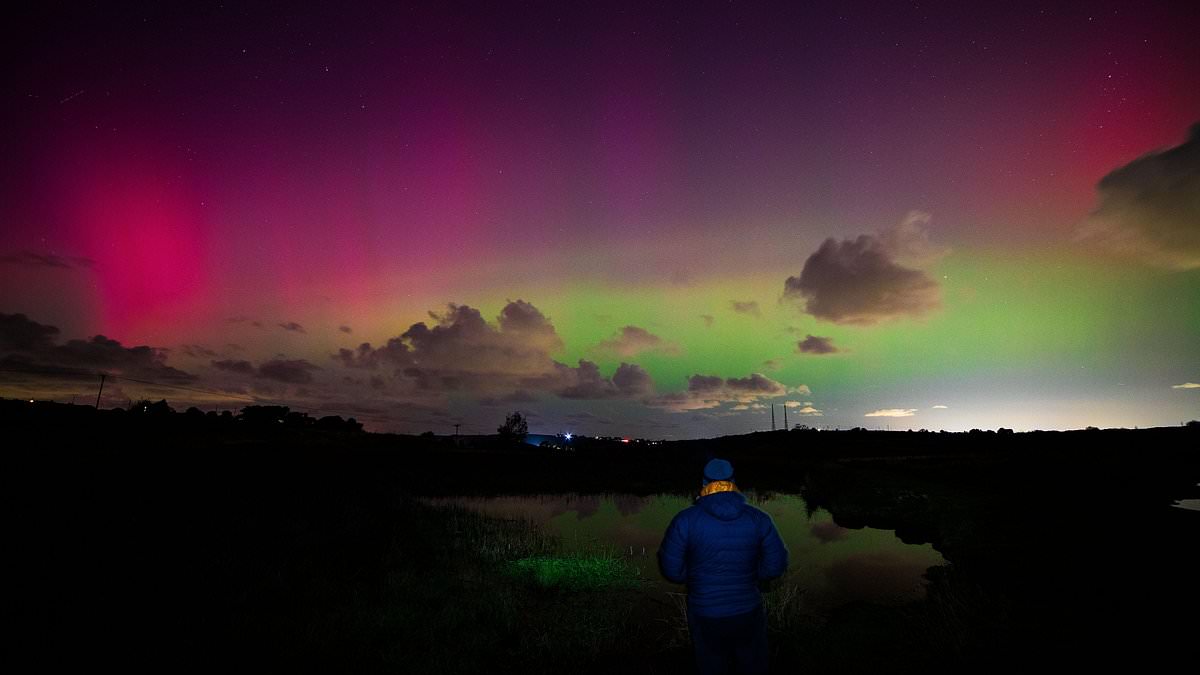The Northern Lights dazzled in the night sky as stargazers across the UK have been left stunned by the phenomenon this evening.
Also known as aurora borealis, it was flagged by the Met Office as potentially being visible as far south as London tonight, as a ‘severe’ geomagnetic storm slams into Earth.
Pictures shared on social media tonight show large swathes of the country draped in a spectacular light display. The lights were spotted dancing across Britain’s skies as far south as West Sussex.
Amazing shades of green and purple were captured in the skies above the UK including in Tyne and Wear, Cumbria, Yorkshire, Nottinghamshire, Buckinghamshire and Northampshire.
‘Aurora sightings are likely across Scotland and Northern Ireland, perhaps across northern England,’ the Met Office said earlier in the day.
‘[There is] a slight chance of sightings across parts of the Midlands or the south of England where skies are clear.’
Taking to Twitter, the Met Office also said: ‘Look north in the coming nights and you may spot the Northern Lights
‘A coronal mass ejection from the sun is earth bound and whilst there’s some uncertainty on its arrival time, sightings of the aurora are likely in northern areas with a slight chance in the south too.’
Aurora displays occur when charged particles collide with gases in the Earth’s atmosphere around the magnetic poles.
As they collide, light is emitted at various wavelengths, creating colourful displays in the sky.
In the northern hemisphere, most of this activity takes place within a band known as the aurora oval, covering latitudes between 60 and 75 degrees.
When activity is strong, this expands to cover a greater area – which explains why displays can be occasionally seen as far south as the UK.
The UK was previously treated to the Northern Lights in August, when they were visible as far south as Cornwall.
In May, thousands of people flooded their social media with their photographs of the phenomena after the Northern Lights appeared strongly over a large part of the UK.
The Northern and Southern Lights (auroras) are natural light spectacles.
The displays light up when electrically charged particles from the sun enter Earth’s atmosphere.
Usually the particles are deflected by Earth’s magnetic field, but during stronger storms they enter the atmosphere and collide with gas particles such as hydrogen and helium.
These collisions emit light in many amazing colours, although pale green and pink are common.
What causes the Northern Lights?
The Northern Lights are caused by a ‘severe’ geomagnetic storm – a major disturbance of Earth’s magnetosphere, the area around Earth controlled by the planet’s magnetic field.
This disturbance is triggered when a violent stream of charged particles released from the sun’s outermost atmospheric layer is directed towards us.
‘There’s a reaction called nuclear fusion that occurs continuously deep within the sun’s core,’ explains Dr Amoré Elsje, an applied geomagnetic researcher at SANSA Space Science, in a new piece for The Conversation.
‘This generates massive amounts of energy.
‘Some of the energy is released as light (sunlight), some as radiation (solar flares), and some as charged particles.’
At this point, charged particles travel down the magnetic field lines at the north and south poles into our planet’s atmosphere.
There, the particles interact with gases in our atmosphere, resulting in beautiful displays of light in the sky, known as auroras.
Oxygen gives off green and red light, while nitrogen glows blue and purple.
Dr Elsje said there were solar flares – intense emissions of electromagnetic radiation – and coronal mass ejection (CME) from the sun that have just reached us.
CMEs are larger bursts of energy send clouds of these charged particles hurtling through space at a relatively lower speed, so their aurora effects are usually felt slightly later.
Are geomagnetic storms dangerous?
Although not dangerous to humans, geomagnetic storms can damage power grids on Earth and satellites in orbit, which can lead to internet disruptions.
One of the most notable dangers is to power grids, according to Dr Elsje.
‘Powerful storms can induce electric currents in power lines, potentially overloading transformers and causing blackouts,’ she said.
Two severe solar storms in modern times caused extensive power cuts in Quebec, Canada, in 1989 and Malmo, Sweden, in 2003.
Why are there so many auroras right now?
Aurora are generally becoming more frequent as we enter solar maximum – the period of peak solar activity during the sun’s 11-year solar cycle, when the surface of the sun is more active than ever.
The solar cycle is the cycle that the sun’s magnetic field goes through about every 11 years, before it completely flips and the sun’s north and south poles switch places.
Scientists can track the solar cycle is by counting the number of ‘sunspots’ – dark areas on the sun’s surface – and when exactly they appear, mostly using satellites.
The beginning of an 11-year solar cycle, when the sun has the fewest sunspots, is known as the solar minimum – but over time the number of sunspots increases as it reaches solar maximum.
A recent study predicted the solar maximum is coming sooner than expected – 2024 rather than late 2025 – meaning space weather will be most pronounced now.
According to the Met Office, people with a decent camera should be able to capture shots of the aurora even when it’s not visible with the naked eye.
Look north if you’re in the northern hemisphere (or south if in the southern hemisphere) and set up your camera likewise.
‘Cameras help as the long exposure allows loads of light in and enhances the colours more than the human eye can see,’ a spokesperson said.
‘That is why you see pictures as far south as Cornwall sometimes though you’re unlikely to see it with the naked eye that far south.’
